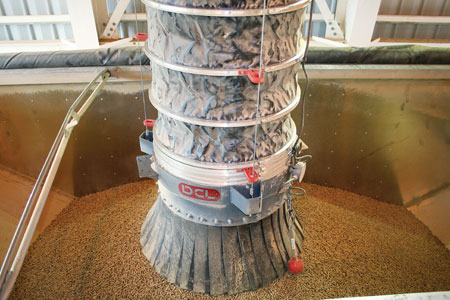Enviva LP has moved into the post-startup phase of its new 350,000 metric tons (386,000 short tons) wood pellet production facility here.
Following an aggressive engineering, construction and startup schedule that began when Enviva purchased the plant site in December 2010, the company produced its first pellets in November 2011, shipped its first 28,000 metric tons at the end of 2011 from its new deep water port terminal in Chesapeake, Va. to one of its European utility customers, shipped its second load, 31,000 metric tons, in March of this year and now plans for the shipment schedule to increase to one to two per month from this facility.
The heightened schedule should come as no surprise to those who have been following Enviva’s emergence into industrial wood pellets production aimed for overseas markets. Already, ground is broken for the company’s second U.S. greenfield plant, planned for 400,000 metric tons capacity, in Northampton County, NC, just west of Ahoskie. A third greenfield plant, due north, in Southampton County, Va., 454,000 metric tons, is in the permitting stage. The company anticipates production to commence at those sites in the first and second quarters of 2013, respectively.
Not to be forgotten are the two pellets plants in Mississippi the company purchased in 2010 from private owners. With expansion at each plant, the combined capacity will be 225,000 metric tons. So if you’re looking for big numbers, here’s one: Enviva’s combined pellet production capacity under ownership in the U.S. could reach more than 1.4 million metric tons (1.54 million short tons) annually based on existing plans. That doesn’t include a plant in Bumpass, Va. which it operates in partnership with Biomass Energy LLC for an average annual production of nearly 115,000 metric tons. Meanwhile, Enviva operates a CHP and pellet manufacturing (50,000 MT) facility in Thimister-Clermont, Belgium.
There’s more: Last November Enviva and ConocoPhillips announced a partnership to create a new company, Eco Biomass Technologies, for the production of torrefied wood pellets from a new facility to be built at a location still to be announced. Enviva also announced last year it had signed a contract to supply biomass (chips) to Dominion Virginia Power for three power facilities in Virginia to be converted from coal.
One reason Enviva chose to locate its three new plants in this region is to take advantage of a wood basket and a raw materials supply infrastructure that was in place and which had once fed a large paper mill nearby, which closed in 2010. The Ahoskie plant requires 725,000 metric tons (800,000 short tons) of biomass annually. When you add in the other two upcoming plants, the combined raw material intake for the three plants will be approximately 2.72 million metric tons (3 million short tons) annually.

Another major reason for the plant locations is the close proximity to the Port of Chesapeake. (Ahoskie is only 45 minutes by truck to the Port). Enviva purchased an existing import terminal, significantly modified it and converted it to an import and export terminal. Enviva installed a 45,000 metric tons silo to store wood pellets with ventilation and heat controls, and new material handling systems feeding into and away from the silo. The site can post dry bulk carrier vessels with 25,000 to 45,000 metric tons capacity. Ships on average require five to six days to reach their destination port.
“We build based on contracts and we have contracts to take care of all three of these (new) facilities for a number of years,” says Elizabeth Woodworth, director of marketing, communications and sustainability. “We have to do it right and maintain our core values of safety, reliability, quality and sustainability.”
The company’s corporate-wide commitment to sustainability begins in the woods and as early as May 2011 Envvia had received certification by the Sustainable Forestry Initiative for its fiber sourcing activities. The certification mandates an auditable procurement process, support for logger and forester training, site reforestation, threatened and endangered species protection and best management practices to protect water quality. The company is currently working toward chain of custody certifications through the Forest Stewardship Council, Sustainable Forestry Initiative, and Programme for the Endorsement of Forest Certification. Chain of custody follows and documents the wood fiber flow from in-woods activities, through plant operations to product shipment and indicates the company adheres to an environmental commitment all along the way.
Given that Enviva is supplying product overseas, and especially to Europe, which is rapidly building its biomass energy infrastructure and gives renewable energy credits to utility companies, Enviva tracks its greenhouse gas footprint from the forests to the utility, such as monitoring trucking and shipping diesel emissions and plant operations. “It (bioenergy) is a very economical and effective way for utilities to reduce their carbon footprint,” Woodworth adds. “That is really what’s driving the market today.”